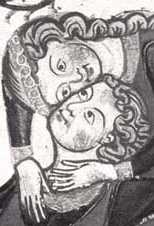Mots Français
Thirteenth CenturyMarie de France (12c-13c)
It is held by some that Marie was an illegitimate daughter of Geoffrey Plantagenet, and served as abbess of Shaftesbury from 1181-1215. What is certain is that the fables and lais attributed to her are among the earliest works that can be said to belong to the mainstream of French literature. The line below is from Le Lai de Chevrefeuil, which is based on an episode from the legend of Tristram and Iseult. It is preceded by an image of intertwined tree and vine which may remind Sinological readers of one of the Six Dynasties "Dz-ye" songs:Ni vous sans moi, ni moi sans vous
No you without me; no me without youFor an echo from later in the mainstream, see Montaigne.
Aucassin and Nicolette (before 1250)
This anonymous chantefable, in alternating prose and verse, still preserves the music to which the verses are to be sung. Like the preceding, it is tale of love. Jau Ling-jr's chantefable based on Ywæn Jvn's romantic tale, also complete with its music, is almost exactly a century earlier in real time (a real time in which the Mongol conquests had created a highway for ideas across Asia and into Europe). Here, Aucassin declares his willingness to go to Hell, with all the brave nights and amorous ladies, "the harpers and jugglers, and the kings of the world," if only he can be with his sweet friend Nicolette, for without her,En paradis qu'ai-je à faire?
What would I do in Paradise?Rutebeuf (died 1280)
This poem, which may remind Sinological readers of a similar one by Lin Bu (967-1028), laments the loss of former friends who have deserted him in his present troubles, friends "who go with the wind." Notice the alliteration:Et il ventait devant ma porte
And a wind was blowing at my door
25 Dec 2005 / Contact The Project / Exit to French Index Page

